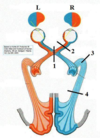Ophtalmology Flashcards
What’s your diagnosis?

Oculomotor palsy
A lesion at #2 would give you which type of vision?

Complete monoocular visual loss of right eye (OD)

What’s your diagnosis?

Abducens nerve palsy: unopposed medical rectus because of disabled lateral rectus
What can cause horizontal diplopia?
LR (CN VI) or MR (CN III) problem
A lesion at #4 would give you which type of vision?

Left homonymous hemianopsia

RighA lesion at #3 (Meyer’s loop) would give you which type of vision?

Left superior quadrantanopsia

What nerve is responsible for corneal reflex?
- CN V
- CN VII
A lesion at #1 would give you which type of vision?

Bitemporal hemianopsia

What are the 2 important questions to assess diplopia?
- What does the patient mean?
- If it is two images, is the problem monocular or binocular?
What is the function of cones?
Colors with low sensitivity to light (no colour vision with poor illumination)
What is the function of rods?
Colors for low illumination vision only
What nerve is responsible for pupillary reflex?
CN III
What can cause Horner’s syndrome?
- Lateral brainstem or cervical spinal cord lesion
- Superior cervical ganglion (“Pancoast” lung tumor)
- Carotid artery dissection
Dilation of the pupil is under the control of which system?
Sympathetic
What happens if you have a narrow angle of anterior?
Accumulation of aqueous humour that leads to acute glaucoma




